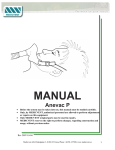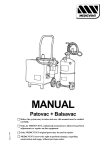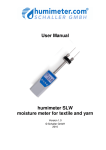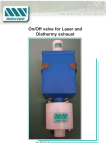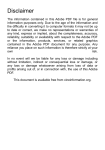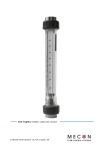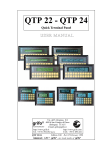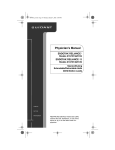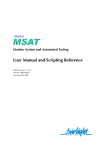Download MANUAL - Medicvent
Transcript
MANUAL Anevac D Before the system may be taken into use, this manual must be studied carefully. Edition 1:1999 Only, by MEDICVENT, authorized personnel are allowed to perform adjustments or repairs on this equipment. Only MEDICVENT original parts may be used in repairs. MEDICVENT reservs the right to perform changes, regarding construction and usage, without previous notice. Table of contents Chapter System components Installation Page 3. 4-5. Handling 6. Technical Data 7. Maintenance 8. Safety 9.- 2 System components Anevac D 9 13 12 ATT, see points 12, 13 below 10 2 1 8 3 6 4 11 5 7 1. The Double nose mask (3 sizes) consists of an inner mask from Matrix (USA) and an outer mask of Polysulfon specially adapted by Medicvent. The inner mask is softly concave to achieve an optimal fit to the patients face. The outer mask can be manufactured for other products as well as this one. 6. 7. 8. 9. 10. 11. 2. A coupling house specially designed to enable connection of the evacuation hose to the nose mask. Accessories: 3. Evacuation hose from nose mask (Ø 19 mm) 4. Chin mask of transparent silicon. The mask is kept in place by a strong plastic snap equipped rubber strap, which can be used several times. Distributor block Flow meter with cutdown Evacuation tube (Ø 40 mm) Control box which remote controlles the fan unit Auxiliary cable Breathing circle from/to analgesia device. 12. Silencer 13. Regulating valve ATT: Points 12 and 13 are used when there is a central fan unit with sufficient capacity even for Anevac D. 5. Evacuation hose from chin mask (Ø 19 mm) 3 Installation Anevac D Preparations Anevac D is delivered hygienically packaged. The parts included in the package should be cleaned before usage. For instructions look up page 5 “Handling” and heading “Clean and disinfect”. Connection 1. Mount the flow meter so that the indicator arrow points upwards. Install the meter in a suitable place so that all hoses come from the same direction. 2. Connect the evacuation tube (Ø 40 mm) to the flow meter. If Medicvent ejector is used, connect it to the left side of the flow meter with the bayonet coupling downward. Then connect the evacuation tube to the ejector. Stationary fanunit: 3. Connect the other end of the evacuation tube (Ø 40 mm) to the Anevac systems outlet where this outlet is placed. (Normally, wall outlet in carerooms wall panel) 4. Connect the control box to the stationary mounted connection with the auxiliary cable. N.B! If central fan unit is used; connect the silencer and the regulating valve to the evacuation outlet and then connect the evacuation tube to the silencer (See component description previous page) The regulating valve is used to obtain the correct evacuation flow. It is important to verify that the fan unit used, has enough capacity to meet up with Anevac D:s demands on evacuation flow, before installation of this alternative. Mobile fanunit: 3. Connect the other end of the evacuation tube (Ø 40 mm) to the fan units inlet marked with an arrow that points inwards. WARNING! Must be installed correctly! The left inner connection, seen from behind. If not polluted air will be blown through the Anevac system. 3a. Also connect another evacuation tube (Ø 40 mm) to the fan units outlet marked with an arrow that points outwards. Connect the other end of the tube to a suitable evacuation device. 3b. Connect the safety isolating transformers connection device to the fanunit. This applies especially to hospitals. WARNING! A system without a safety isolating transformer does not comply with norm IEC 601:1. Sensitive equipment might be disturbed. 3c. Connect the Mains cable from the safety isolating transformer to suitable power supply. 4. Connect the control box to the fan unit with the auxiliary cable. 5. Connect the distributor block to the flow meter. 6. Connect the evacuation hoses (Ø 19 mm) for nose- and chin mask to the distributor block. 7. Connect the evacuation hoses other end to the chin mask respectively coupling house. The coupling house is 360o turnable so that the hose can be placed in such a way that it doesn´t interfere with the treatment. 4 Installation Anevac D 8. Connect the nose mask to the coupling house. 9. Connect the breathing hoses from the analgesia device to the nose mask. One hose on each side of the mask. 10. If the analgesia device doesn´t have a nonreturn valve, one can be attached to the breathing circle in the form of an Anevac D/HB-set. Flowmeter: 11. Test the analgesia system for leaks and function together with the coupling house and the nose mask. 12. Activate the fan with the control boxes on/offswitch. 13. In this Anevac system a flow meter with three engraved marks is used. The marks corresponds to different air flows: Upper mark (high flow) = 35 m3/h (583 l/min) Middle mark = 27 m3/h (450 l/min) Lower mark (low flow) = 17 m3/h (290 l/min) On the control box there are two adjustment screws for high- and low flow. High flow is normally adjusted to lie between 27–35 m3/h, i.e. between the two upper marks, when chin masks from two patients are hooked up to evacuate expiration gases. When only one chin mask is hooked up the fan unit is run on low flow, which has been adjusted to approx. 17 m3/h, i.e. the lower mark. Controlbox: high flow adjustment low flow adjustment low flow high flow 5 Handling Anevac D Directions for use Clean and disinfect • Activate the fan with the control boxes on/offswitch. All close to patient details, the double nose mask, the chin mask, the coupling house, the rubber strap, the distributor block, the evacuation hoses (Ø 19 mm), and the regulating device can be autoclaved in 120° C or washed in a decontaminator without any affects on the materials. Flow meter and control box need only be surface disinfected. In reference to cleaning and disinfecting the Anevac systems components can be divided into three groups: • Check the evacuation flow against the flow meter (See Installation, previous page). If indication by the flow meter is incorrect a leakage in the system might be suspected. Then check the hose connections or contact technical support at your hospital. • Important! Use a hose holder when possible. This is to enable positioning of the hoses so that as little effort as possible is needed to hold the mask in place. • The coupling house is 360° turnable so that the hose can be placed in such a way that it doesn´t interfere with the treatment. • The mask is held against the patients face by the analgesia hoses which are attached together with a hose clip, behind the patients head. • The mask can be removed from the patients face and put aside, without the gas flow having to be shut off or readjusted. There is no risk of gas spreading out into the surrounding air since it is evacuated with the air flowing in between the outer- and the inner mask. • Attach the chin mask to the patients face with the enclosed rubber strap which should be placed around the patients head. Local evacuation (point-evacuation) Anevacs evacuation system can be used as local evacuation. Group 1 Decontaminator (80–85°C) or autoclave (120° C): Double nose mask (all parts) Chin mask (all parts) Coupling house (all parts) Hoses of hytrel Distributor block Regulating device Anevac D/HB nonreturn-valve set Group 2 Washing in mild detergent (60–70° C): Evacuation tube Ø 40 mm Soft muffs Group 3 Wipe off with disinfectant: Flow meter Control box Cables Ejector Silencer Fan unit (if it is located in the same room as the patient) Safety isolating transformer (used in mobile fan unit) N.B! Detergent with a high pH-value might cause discolouration of the aluminium connections (flow meter). Some alcohol dissolvents might cause damages to the flow meter (acrylic plastic) and the control box. 6 Technical data Anevac D Component Material Cleaning grp. Double nose mask, compl. outer mask Transparent polysulfon inner mask Matrix (porter) Group 1 Coupling house, complete Transparent polysulfon Group 1 Chin mask Transparent silicon Group 1 Strap with plastic snaps EPDM rubber Group 1 Analgesia hoses Hytrel Group 1 Anevac D/HB nonreturn valve set Pom Acetal Group 1 Evacuation hose (Ø 19 mm) Hytrel Group 1 Distributor block Acetat Group 1 Flow meter Aluminium alloy, akryl Group 3 Muff (Ø 40 mm) PVC Group 2 Evacuation tube (Ø 40 mm) PVC Group 2 Control box PVC Group 3 Auxiliary cable PVC Group 3 Silencer Aluminium Group 2 7 Maintenance Anevac D Flow meter Annual cleaning, i.e. blow through the canals and check calibration. If the system works in accordance with this manual and the flow meter at hand, there is no further need for any service or maintanence. Hytrelhoses • Recommended time of use max 24 months or 200 washings. • Store dark. Avoid sunlight during use. • Always perform tightness test before use. • Spare hoses must always be at hand. • Hose that has turned yellowish must be replaced. 8 Safety Anevac D WARNING! Constitutes a risk for injuries on patient and user. N.B! Constitutes a risk for damages to equipment. Only use components that MEDICVENT has delivered and/or approved. ATT: Attention, reference. Safety Anevac D • Only by MEDICVENT authorized personnel are allowed to perform adjustments or repairs on this equipment. • Only MEDICVENT original parts may be used in repairs. WARNING! When using a mobile fan unit the evacuation tube from the flow meter must be attached correctly. It must be attached to the fan units inlet marked with an inward pointing arrow. Otherwise polluted air will be blown through the patient system. WARNING! A system without a safety isolating transformer does not comply with norm IEC 601:1. Sensitive equipment might be disturbed. N.B! If central fan unit is used; connect the silencer and the regulating valve to the evacuation outlet and then connect the evacuation tube to the silencer (See page Systemcomponents). The regulating valve is used to obtain the correct evacuation flow. It is important to verify that the fan unit used, has enough capacity to meet up with Anevac D:s demands on evacuation flow, before installation of this alternative. N.B! Detergent with a high pH-value might cause discolouration of the aluminium connections (flow meter). Some alcohol dissolvents might cause damages to the flow meter (acrylic plastic) and the control box. 9









